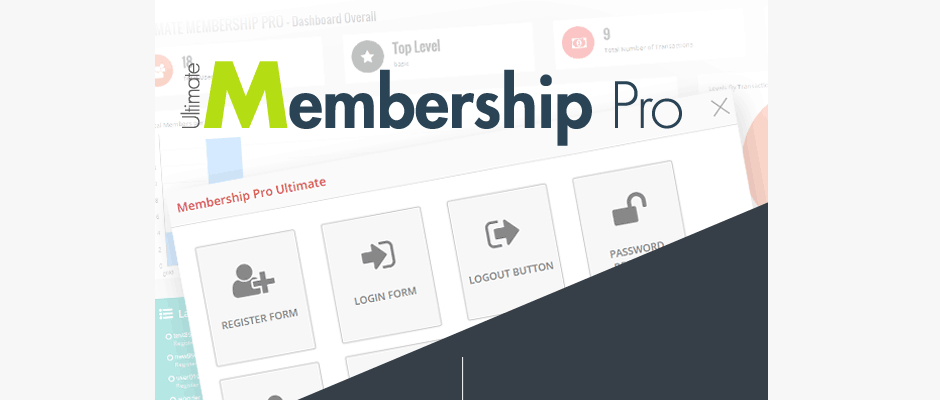With WordPress, you can create a premium subscription membership website and be a part of the worldwide market worth over $50 trillion per year.
WordPress is a free, open source platform you can use to create a robust membership website and a recurring, passive income.
With some planning and elbow grease, you can rub your elbows with other big-time membership sites like Netflix, Amazon Prime, YouTube Red, Adobe, Spotify, Pandora, HBO, Dollar Shave Club and tons more.
Today, I’ll provide more detail on membership sites, how you can formulate an idea and plan one of your own. I’ll also share the top plugins and services you can use to create your own premium membership website.
What’s Membership Got to Do with It?
A membership site is a type of website that has some content publicly available, but other chosen content privately hidden. In order for someone to view the hidden content, they need to sign up for an account.
A premium membership site goes one step further and offers a membership account at a cost to the user.
If the membership fee is ongoing for a set period of time or until the user cancels, it’s called a subscription. It’s similar to a magazine subscription that way, only digital.
As previously mentioned, subscription memberships have crept up over the years and have exploded into a huge market and opportunity.
In 2014, Netflix reported $5.5 billion in revenue and has continued to grow since then.
They’re not alone. Worldwide, subscription memberships based on cloud services raked in $219.6 billion in 2016.
It’s become such a lucrative market that business are changing by the droves. Adobe changed their business model from a one-off payment for their software into a subscription membership and as a result, they saw $1.46 billion in revenue in the third quarter of 2016.
In fact, technology research company Gartner has projected that by 2020, 80 percent of software businesses will change their business model to subscription memberships.

Membership websites selling subscriptions is a trillion dollar industry.
Everyone Loves Memberships
It’s easier to understand why so many companies around the world are choosing this kind of business model when you take a look at all the benefits of a membership site with subscriptions.
For members, it’s an overall practical option:
- Users can set up a membership and forget about it. They don’t have to worry about reordering in time to continue getting the benefits they signed up for with the membership.
- It’s scalable to members. They can downgrade or upgrade when it’s right for them.
- All users can enjoy the same benefits so every member feels valued.
- In terms of software memberships, company teams that purchase a subscription can rest assured they all have the latest updates so it drags down productivity a lot less.
- Subscriptions are typically a lot more affordable to a lot more people. For example, instead of a one-off payment of $500, users can more easily budget for about $40 per month for a year.
There are also several reasons why businesses benefit big-time from memberships:
- The regular income means it’s easier to predict profits and plan for the future.
- This recurring revenue also means less marketing for businesses.
- Along the same lines, that kind of almost guaranteed income means it boosts a company’s value..
- Continuing that thought, a better company valuation attracts investors and often high-quality ones as well.
- Memberships also reduce the time a product goes to market since you can release an imperfect project and refine it as you go, collecting feedback and bug reports along the way.
- A quicker turnaround time for users to get a product into their hands, though imperfect, still adds value to a membership, which makes users happy.
- The regular income also assists in the costs of upkeep for the membership site.
While there are so many ways a membership site is advantageous to businesses, there are a couple downsides. Customer service costs go up as a result of the shorter times-to-market.
Also, for businesses that switch to this subscription model, it can be difficult at best and at worst, it can be unsuccessful if the change isn’t made in an appropriate way.
It’s been a profitable income option for so many outside of the mainstream business behemoths. Smaller companies have also found massive success such as the Dollar Shave Club, which grew from nothing to four million dollars in the first year, to $120 million in 2015.
Then in 2016, the once small-time startup sold for one billion dollars to Unilever.
This kind of near overnight success has rushed out business and marketing consultants to cash-in on the craze and push the idea that membership sites can create recurring, passive income for just about anyone.
But just how realistic is this claim?
Passive Income: Myth or Reality?
Passive Income means money that you make by putting in little to no effort. It’s money that’s made from assets such as real estate, a book you have written, or other kinds of high-value content.
The idea that has been widely spread is that you can make a product or content people want to buy, put it out into the world, start making money from it and continue to do so long after you have stopped putting in the initial effort to create the product.
It sounds amazing and that’s why so many people have been able to sell numerous courses and trainings around creating passive income with membership sites.
So the question is, can you set it up and forget it?
If you completely dismiss the oodles of time it takes to initially create a membership site filled with content and that It’s not something you can create in an afternoon if you want it to be good, there’s still a lot of work involved after the fact.
After your membership site is set up and ready to go, you need to have already started marketing to pull in new users right from the get go. You also need to continue marketing long after the initial setup because it’s inevitable to have at least some members unsubscribe regularly.

Creating a membership website takes a lot of work in multiple stages of development.
If your memberships are also ongoing with no end date, you should also expect to constantly create new and valuable content to push out to members in order to keep them interested, and ultimately, subscribed.
While this may not always be necessary, you also need to maintain your site to make sure there are no security issues or bugs that arise and cause havoc among your users. You can outsource this, but at this point, passive income looks a lot more like any other business.
The biggest difference is that there’s a lot more freedom to be had than a traditional nine to five job. You can work at home, in your pajamas and create your own schedule, for example.
At the end of the day, there’s huge potential for success and that’s something worth paying attention to, but it’s important to be realistic.
While you may not be able to make money without ever lifting a finger from your membership site, you can set it up so it’s low maintenance while also making recurring income—revenue that you earn regularly that you can predict to some degree of certainty.
While creating a premium membership site is going to take time and is likely to replace a full-time job in terms of the hours you put in, there’s also potential to profit which can resemble a full-time, regular income.
It’s still a business, though, and should be treated as such.
Bottom line: The phrase “recurring income” is more accurate than its “passive income” counterpart. It just doesn’t have as much zing to it.
Different Strokes for Different Sites
Creating a premium membership site can be a worthwhile way to recurring income, but before you can start thinking up ideas and setting everything up, it’s important to understand the different things you can do to create this kind of website with WordPress.
There are many different kinds of membership sites you can create including:
- Free membership with premium subscription upgrades
- One or more premium subscriptions
- Premium membership with other paid upgrades or subscriptions
- Free account with other paid subscriptions or upgrades
Beyond that, you can get even more specific with the type of premium memberships and business models you can offer, each with their own upsides and downsides.
Continuous
A continuous membership is one that’s ongoing and has no end date. This creates recurring income, but you also need to be prepared to regularly publish new and high-value content to keep people subscribed.
You otherwise need to be able to provide a continuous solution to an ongoing problem if you don’t plan to need continuous updates to the content you provide.
Evergreen
An evergreen subscription is named after the coniferous tree because it stands on its own year round. You can set it up once with low maintenance because the membership doesn’t include content that will expire or quickly become obsolete.
While updates may be necessary eventually, you could still sell it for quite some time without worry.
You don’t need to regularly add content and you don’t necessarily need ongoing, huge launches. (marketing campaigns designed to get a flood of customers) However, this results in a high unsubscribe rate, which means you need to have enough new customers signing up through regular efforts such as an email list or you need to be able to offer users something else.

Evergreen refers to content that doesn’t expire and becomes irrelevant quickly.
Free with membership upgrade
These kinds of memberships have the same problem as the other options depending on the kind of premium membership you want to offer of the ones on this list. Refer to them for more detail.
Although this membership type has a low barrier to entry for users, it can potentially be difficult to convince members to upgrade.
Freemium
A freemium membership is free for users to sign up to gain access to certain content, but rather than offering a premium subscription upgrade, you would offer other individual products or content for a regular one-time fee in exchange for access to it.
It’s easier to get a lot of signups, but you would need to be constantly marketing your premium upgrades in some way. Otherwise, it would be tricky to get recurring income.
Free trials
You can offer a free (or cheap as free!) trial for a predetermined amount of time, then automatically or manually roll them onto a paid subscription.
This strategy offers a low barrier to entry, but it can be a challenge to keep people from unsubscribing before the trial ends.
It’s also common for users to get excited, sign up, but then forget about the membership, only to unsubscribe soon after when they don’t remember what the credit card charge was for in the first place.
This is where onboarding would be an essential part of your membership site.
In this case, it refers to customer onboarding, which is the process of helping customers become familiar with your product or service quickly. The secondary goal is to ensure users stay interested so that they continue being a customer.
For details, check out Customer Onboarding: It’s all about first impressions.
Another strategy you could use to keep users from unsubscribing is to offer a one dollar trial rather than a completely free one. It’s practically free so most people aren’t going to mind the charge and it also subconsciously adds more value to what you’re offering because it’s not free.
However, because it’s still practically free, onboarding would still be an important factor to keep users interested.
Onboarding doesn’t have to be complicated. It can be as straightforward as setting up a newsletter platform such as MailChimp with scheduled emails. Each email can help a customer learn their way around while also reminding them why they signed up.

Distractions are aplenty when users surf the web.
Standard Subscription Structures
With most WordPress membership plugins, there are also standard ways you can display protected content within your membership site.
Here are the most common structures to decide upon:
- Standard (Continuous) – A free or premium, ongoing membership
- Drip Feed – Content is released on a preset schedule where users cannot skip ahead
- Date Range – Content is only available within a preset span of time
From Ideas to Planning
With all that in mind, you can start planning out your membership site and the content you plan to offer.
Here are some ideas to consider when formulating your site:
- Find a problem that a lot of potential users have where you can offer a solution.
- Robert Plank suggests finding an overlap between what people ask for, what they want to pay money for and what you can provide.
- It’s also important to consider what skills or knowledge you have that you can offer.
- You shouldn’t base your premium subscription around an answer, but a transformation. In other words, members need to be left with something quantifiable and high-value after sticking with your subscription than when they initially decided to sign up.
When it comes to figuring out who you’re trying to sell your memberships to, think about who you ideally would want as your users and who would realistically want to sign up. In the middle is the foundation for doing some additional research on your target audience.
For details, check out How to Define Your Target Audience and 5 Free Market-Research Tools to Read Your Audience’s Minds (And Create Content to Delight Them).
Once you have found your target audience, you can do some keyword research to help you decide on how to offer them what they want, they way they want to consume it.
Check out How to Scale Up Your Business with Online Courses.
Knowing your target audience can help you also decide on a pricing structure. To find out what the best price would be to set, think about what would typically be right for them.
Depending on what you’re offering, $27 per month is a great place to start since it’s within most people’s reach. You also raise your prices later as well.
Keep in mind that this isn’t always the best solution. If your target audience is high-powered business executives, then that price point would be entirely too low in most cases.
Muse to My Ears
If you’re not sure what kind of content you should offer in your premium membership site, here are some ideas to help you brainstorm one that’s right for you:
- Mastermind group coaching or support forums
- A members only area with products like ebooks, courses, training videos and similar content
- Continue offering content such as blog posts (particularly helpful if you have a strong following already)
- Infrastructure as a Service (IaaS)
- Platform as a Service (PaaS)
- Software as a Service (SaaS)
- Location as a Service (LaaS)
- Logging as a Service (LaaS)
- Anything as a Service (XaaS) or also known as everything as a service is used to illustrate the point that cloud computing has near infinite possibilities and there many other avenues you could take:
If you reach a point where you’re still unable to come up with an idea that excites you, try starting your thought process again with the steps mentioned above.
Setting Up Your Membership Site
Once you’re done brainstorming, you have an idea and you’re raring to go, you can start setting up your premium membership site with WordPress plugins.
These are the top plugins for creating membership websites and subscriptions. They’re also updated regularly for added security.
MemberPress

MemberPress is a robust and premium option for creating functional, yet stunning membership sites. Not only is it easy to use with a whole slew of professional tools included, but you can also track free and premium memberships with their built-in analytics.
WooCommerce Memberships

This is a WooCommerce extension that’s practically a no brainer to use because of it’s ultra clean and intuitive interface. You can sell memberships, create advanced coupons and you can send emails to members directly in your dashboard.
It’s also worth noting that you can use this extension by itself, but you do also need the subscriptions extension if you want to accept recurring payments.
Paid Memberships Pro

This plugin has everything you need to get started with creating your membership site from letting you create premium subscriptions with recurring payments to extensive options for protecting your content and managing users.
Ultimate Membership Pro

Ultimate Membership Pro gives you the ability to protect basically any kind of content you can think of from pages and products to categories, post sections and images. If you don’t find what you need, you can also add your own custom protection rule.
You can also let your users log in with their social media accounts.
Membership 2

Membership 2 is a free plugin that’s incredibly simple to set up and use. It has an install wizard that guides you through setting up your site in minutes. You can create free or paid memberships and also standard or drip feed subscriptions.
There’s also a premium version available with tons more features including profile fields, letting members have multiple, different subscriptions at a time and the ability to pro-rate payments just to name a few.
Wrapping up
Creating a premium membership website can create recurring income for you and with the right idea, you can even make it big like Netflix or Spotify.
If not, there’s still a massive worldwide move to subscription sites because they’re a business model that works incredibly well.
With WordPress, you can make it happen and practically automatically, too, with the right tools and services.
Are you interested in creating a premium membership website? Is there a point in the process where you’re stuck? What kind of goals do you have? Feel free to comment below with your experience.
Read other posts about:
Leave a Reply
Discover your innate talents and embrace them as the foundation to personal and business success. Walk away with personalized tips to help you overcome the mental hurdles unique to your brand builder personality.
What’s your brand builder personality?
Take the quiz
Leave one here
Comments